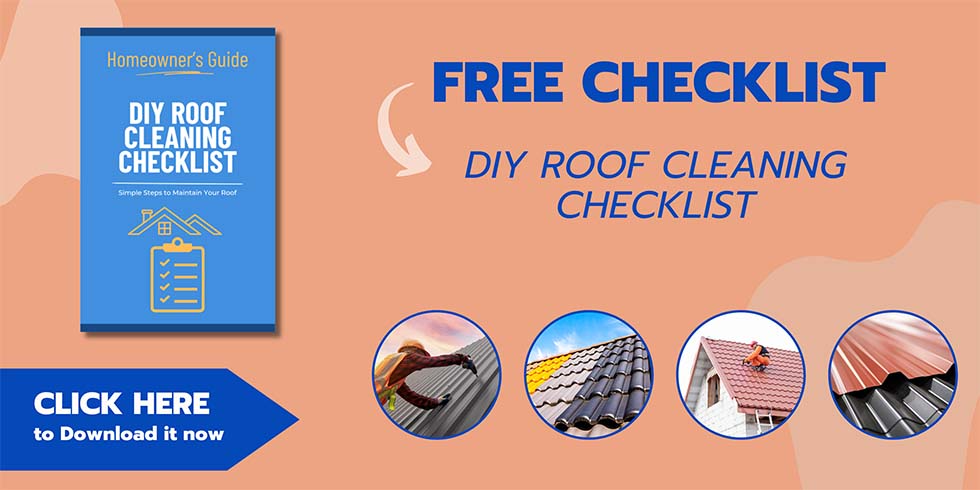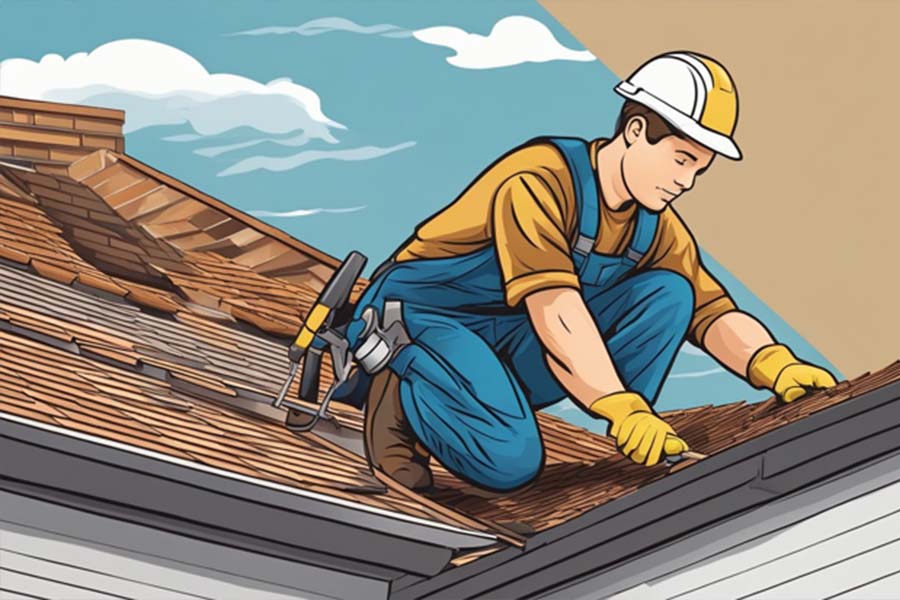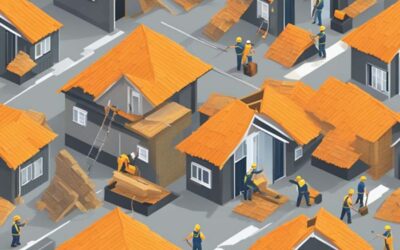Regular roof maintenance is an essential aspect of homeownership that is often overlooked. A well-maintained roof can prevent major issues such as leaks, mold growth, and structural damage. In contrast, neglecting roof maintenance can lead to costly repairs and even the need for a complete roof replacement.
One of the primary benefits of regular roof maintenance is the prevention of leaks. Leaks can cause significant damage to a home’s interior, including walls, ceilings, and floors. They can also lead to mold growth, which can be harmful to the health of those living in the home. By performing regular maintenance, such as inspecting and repairing any damaged shingles or flashing, homeowners can prevent leaks from occurring and avoid costly repairs down the line.
Understanding Roof Maintenance
Key Components of a Roof
A roof is made up of several components that work together to protect a building from the elements. The key components of a roof include the following:
- Roof covering: This is the outermost layer of the roof that is exposed to the elements. It can be made of various materials, including shingles, tiles, metal, or slate.
- Roof deck: This is the structural base of the roof that supports the roof covering. It is usually made of wood or metal.
- Underlayment: This is a water-resistant layer that is installed between the roof covering and roof deck. It helps to prevent water from penetrating the roof.
- Flashing: This is a material that is used to seal the joints and seams of the roof. It is typically made of metal and is installed around chimneys, vents, and other roof penetrations.
- Gutters and downspouts: These are components that are used to collect and channel rainwater away from the roof and the building’s foundation.
Importance of Regular Inspection
Regular roof maintenance is essential for preventing major issues and extending the life of a roof. One of the most important aspects of roof maintenance is regular inspection. Here are some reasons why regular inspection is important:
- Early detection of issues: Regular inspection allows for the early detection of issues such as leaks, cracks, and damage to the roof covering. Early detection can prevent these issues from becoming major problems that require costly repairs.
- Preventative maintenance: Regular inspection allows for preventative maintenance to be performed. This includes tasks such as cleaning gutters, replacing damaged shingles, and sealing joints and seams.
- Compliance with warranty requirements: Many roofing warranties require regular maintenance and inspection. Failure to comply with these requirements can void the warranty and leave the building owner responsible for costly repairs.
In conclusion, understanding the key components of a roof and the importance of regular inspection is essential for maintaining a roof’s integrity and preventing major issues. By performing regular maintenance and inspection, building owners can ensure that their roofs provide reliable protection from the elements for many years to come.
Common Roofing Problems and Prevention
Leaks and Water Damage
One of the most common roofing problems is leaks and water damage. This can be caused by a variety of factors such as poor installation, damaged or missing shingles, or clogged gutters. Leaks can lead to serious damage to the roof and the interior of the building, including mold growth and structural damage.
To prevent leaks and water damage, regular roof inspections and maintenance are essential. This includes checking for damaged or missing shingles, ensuring proper drainage, and clearing debris from gutters and downspouts. It is also important to address any leaks as soon as they are detected to prevent further damage.
Weather-Related Damage
Weather-related damage is another common issue that can affect roofs. This includes damage from hail, wind, and heavy rain or snow. Over time, exposure to extreme weather conditions can weaken the roof and lead to cracks, leaks, and other issues.
To prevent weather-related damage, it is important to choose roofing materials that are appropriate for the climate and to ensure that the roof is properly installed and maintained. This includes regular inspections to check for damage and wear and tear.
Wear and Tear Over Time
Roofs are exposed to a variety of environmental factors that can cause wear and tear over time. This includes exposure to UV rays, temperature fluctuations, and general wear and tear from age and use. Over time, this can lead to cracks, leaks, and other issues.
To prevent wear and tear over time, regular roof maintenance is essential. This includes inspections to check for damage, repairs as needed, and regular cleaning to remove debris and prevent clogs in gutters and downspouts. Choosing high-quality roofing materials and ensuring proper installation can also help to extend the lifespan of a roof.
Maintenance Strategies
Routine Cleaning
Regular cleaning of the roof is an essential part of maintenance. Dirt, debris, and other materials can accumulate on the roof and cause damage over time. Routine cleaning can help prevent this damage and extend the life of the roof.
Cleaning the roof involves removing any debris, such as leaves or branches, that have accumulated on the roof. This can be done using a broom or a leaf blower. It’s also important to clean out gutters and downspouts to prevent water from backing up and causing damage.
Dealing with Vegetation
Vegetation can also cause damage to a roof. Trees and other plants can grow into the roof, causing damage to the shingles or other roofing materials. It’s important to trim back any trees or plants that are growing too close to the roof.
Moss and algae can also grow on the roof, especially in areas with high humidity or moisture. These can cause damage to the roof over time. Regular cleaning can help prevent the growth of moss and algae.
Proactive Repairs
Proactive repairs are another important part of roof maintenance. It’s important to address any issues with the roof as soon as they arise. This can help prevent more significant damage and extend the life of the roof.
Some common issues that may require repairs include damaged or missing shingles, leaks, and cracks in the roof. It’s important to have these issues addressed by a professional to ensure that they are fixed properly.
By following these maintenance strategies, homeowners can help prevent major issues with their roof. Regular cleaning, dealing with vegetation, and proactive repairs can all help extend the life of the roof and prevent costly repairs down the line.
Cost-Benefit Analysis
Regular roof maintenance can seem like an unnecessary expense, but it can actually save property owners a significant amount of money in the long run. A cost-benefit analysis can help property owners understand the financial benefits of regular roof maintenance.
Long-Term Savings
By investing in regular roof maintenance, property owners can avoid costly repairs and replacements in the future. Regular maintenance can identify and address small issues before they become major problems that require expensive repair work or even a full roof replacement.
For example, a small leak can be easily repaired if caught early, but if left unaddressed it can cause significant damage to the roof structure and even the interior of the building. This can result in costly repairs and potential downtime for the business.
Value Preservation
In addition to long-term savings, regular roof maintenance can also help preserve the value of the property. A well-maintained roof is a key factor in the overall value of a property, and can help property owners command a higher price if they decide to sell in the future.
On the other hand, a poorly maintained roof can significantly decrease the value of a property and make it less attractive to potential buyers. By investing in regular roof maintenance, property owners can ensure that their property retains its value and remains an attractive investment.
Overall, a cost-benefit analysis shows that regular roof maintenance is a smart investment for property owners. By identifying and addressing small issues before they become major problems, property owners can save money in the long run and preserve the value of their property.
Professional vs. DIY Maintenance
When to Hire a Professional
Regular roof maintenance is crucial to prevent major issues, but sometimes it’s best to leave the job to a professional. Here are some situations where hiring a professional is recommended:
- Roof age: If the roof is over 20 years old, it’s best to have a professional inspect it. They can identify any potential issues and recommend the best course of action.
- Complex roof design: If the roof has a complex design, such as multiple angles or slopes, it’s best to hire a professional. They have the expertise and equipment to safely navigate and inspect these types of roofs.
- Safety concerns: If the roof is steep or has a high pitch, it’s best to hire a professional. They have the necessary safety equipment and training to work on these types of roofs.
DIY Maintenance Tips
While some situations require a professional, there are still plenty of maintenance tasks that can be done by the homeowner. Here are some DIY maintenance tips:
- Clean gutters: Clogged gutters can cause water to back up and damage the roof. Clean gutters at least twice a year to prevent this.
- Inspect for damage: Regularly inspect the roof for any damage, such as missing or cracked shingles. Catching these issues early can prevent more extensive damage.
- Trim trees: Trees that overhang the roof can cause damage if they fall or rub against the roof. Trim any overhanging branches to prevent this.
Remember, regular maintenance is key to preventing major issues with your roof. Whether you hire a professional or do it yourself, make sure to prioritize roof maintenance to keep your home safe and protected.
Seasonal Maintenance Considerations
Spring and Summer Care
During the spring and summer months, it is important to perform regular maintenance on your roof to prevent any potential issues from arising. One of the most important tasks is to clear any debris, such as leaves and branches, that may have accumulated on the roof. This can be done using a broom or a leaf blower.
In addition, it is important to inspect the roof for any signs of damage, such as cracks or missing shingles. If any damage is found, it should be repaired as soon as possible to prevent further damage from occurring.
Another important task is to check the gutters and downspouts for any blockages. Clean gutters and downspouts will help ensure that rainwater is properly diverted away from the roof and foundation of the home.
Fall and Winter Preparation
As the fall and winter months approach, it is important to prepare your roof for the colder weather. One of the most important tasks is to ensure that the roof is properly insulated to prevent heat loss and ice dams from forming.
It is also important to check the roof for any signs of damage, such as cracks or missing shingles. Any damage should be repaired before the colder weather sets in to prevent further damage from occurring.
In addition, it is important to clear any debris, such as leaves and branches, from the roof and gutters. This will help prevent any potential blockages that could lead to water damage.
By performing regular seasonal maintenance on your roof, you can help prevent major issues from occurring and prolong the lifespan of your roof.
Safety and Compliance
Adhering to Building Codes
Regular roof maintenance is not only beneficial for the longevity of the roof but also for the safety of the building occupants. Adhering to building codes is essential for ensuring that the roof is structurally sound and capable of withstanding various weather conditions. Building codes are designed to ensure that the roof is installed, maintained, and repaired in a safe and compliant manner.
It is important to hire a professional roofing contractor who is knowledgeable about local building codes and can ensure that the roof is in compliance. Failure to adhere to building codes can result in fines, legal liabilities, and even property damage.
Safety Precautions During Maintenance
Roof maintenance can be dangerous and should only be performed by trained professionals with proper safety equipment. Safety precautions such as wearing personal protective equipment, using safety harnesses, and following proper ladder safety protocols should be followed at all times.
It is also important to ensure that the roof is free of any debris or obstacles that can cause slips, trips, or falls. Proper signage should be used to indicate any potential hazards and to keep unauthorized personnel away from the work area.
In conclusion, adhering to building codes and taking proper safety precautions during roof maintenance can prevent major issues and ensure the safety of the building occupants. Hiring a professional roofing contractor who is knowledgeable about local building codes and safety protocols is essential for maintaining a safe and compliant roof.
Roof Maintenance and Sustainability
Eco-Friendly Materials
Regular roof maintenance not only prevents major issues but also contributes to the sustainability of the environment. One way to achieve this is by using eco-friendly roofing materials. These materials are made from recycled or sustainable resources and can be recycled at the end of their lifespan. They are also energy-efficient and can help reduce the carbon footprint of a building.
Examples of eco-friendly roofing materials include metal roofs, which can be made from recycled materials and are highly durable. Another option is a green roof, which consists of vegetation and soil layers that provide insulation and improve air quality. Green roofs also absorb rainwater, reducing the load on drainage systems.
Energy Efficiency
Roof maintenance can also improve the energy efficiency of a building. A well-maintained roof can provide insulation, reducing the amount of heat lost in the winter and gained in the summer. This can lead to lower energy bills and a reduced carbon footprint.
Reflective roofing materials can also improve energy efficiency. These materials reflect sunlight, reducing heat absorption and keeping the building cooler. This can lead to lower air conditioning costs and a reduced need for energy.
In conclusion, regular roof maintenance can have a positive impact on the sustainability of a building. By using eco-friendly materials and improving energy efficiency, building owners can reduce their carbon footprint and contribute to a healthier environment.





0 Comments